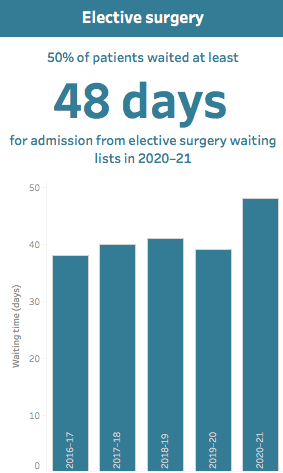Australia’s private hospitals are essential to address the surge of essential elective surgery when restrictions ease, a peak industry body has said.
The number of patients on Australia’s public hospital elective surgery waiting lists increased during 2020–21 as hospitals dealt with a backlog caused by COVID-19 in the previous year.
The proportion of patients who waited longer than 365 days to be admitted increased to 7.6 percent in 2020–21 from 2.8 percent the previous year.
The number of people added to the waiting lists also increased. There were 893,000 patients added to elective surgery waiting lists in 2020–21, up from 838,000 in the previous year, similar to the statistic in 2018–19.
Michael Roff, CEO of the Australian Private Hospitals Association (APHA), a peak industry body, said the increase in waiting times is a big one.

“When you look at surgeries by category, the increases in median wait time are even more significant. Those waiting for head and neck surgery now wait 112 days, up from 84 pre-COVID, while ophthalmology patients wait 118 days rather than 73, an increase of six and a half weeks,” he said in a statement on Tuesday.
Roff argued that private hospitals will play an essential role in clearing the surgical backlog post-pandemic, just as they did in helping the public system with the pandemic response.
“Without private hospitals picking up the slack, Australians will be waiting a great deal longer to have their surgery—often important for quality of life, like cataract surgery to correct impaired vision or joint replacements to remove pain and improve mobility.”
The CEO said restrictions on necessary elective surgery should not last even one day longer than needed.
“With signs, the Omicron wave is plateauing in several states, health departments need to consult with private hospitals about easing restrictions in a safe way, so hospitals are ready to increase surgical capacity to provide much-needed treatment to those Australians who have had surgery deferred.”
He also urged public hospitals to prioritize public patients over privately insure patients after restrictions ease.
“When restrictions ease, public hospitals should not be taking in a single privately insured patient until all of their public patients have been treated. It is time to stop them treating public patients as second-class citizens,” he said.
“It would be morally reprehensible if public hospitals were to bring in a large number of privately insured patients to take advantage of the even longer wait times Australians have had to deal with, while those who need the public system languish on ever-lengthening waiting lists.”




